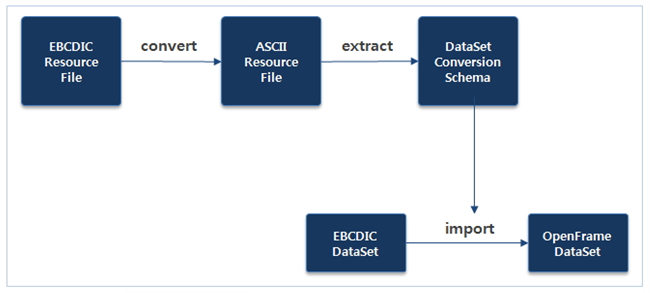OpenFrame Migration
This chapter describes the process of migrating mainframe applications, resources, and data sets to OpenFrame.
1. Resource Migration
Resources are a wide range of system resources, including data sets, CICS resources, and JCL, used by mainframes and OpenFrame. During resource migration, these system resource files are converted from EBCDIC to ASCII, an OpenFrame-compatible format.
The following shows the general process of resource migration.

-
Converts EBCDIC resources to ASCII resources.
-
Imports resources into OpenFrame.
The following tasks are performed during resource migration.
-
Conversion from EBCDIC to ASCII
OpenFrame migration procedures vary by resource type, but all mainframe resources must be converted from EBCDIC to ASCII.
Code conversion is required because IBM Mainframe and an open system use different basic character sets. Therefore, it is a mandatory step during a migration process for rehosting.
-
CICS map migration
To migrate an application using Basic Mapping Support (BMS) in CICS to OSC, the map files used by the application must be migrated as well.
Since OSC cannot use the map files used in CICS as they are, the map source code must be converted from EBCDIC to ASCII, and then compiled with the OSC-provided compiler.
-
CICS resource migration
After a CICS application is migrated to OSC, the existing resource definitions used by the application in CICS must also be migrated to OSC.
-
JCL migration
In a JCL migration, JCLs must be extracted from the existing mainframe’s JES environment and then converted from EBCDIC to ASCII. Although most JCLs migrated in this way will run on TJES without modification, some may require pre-processing.
-
SORT script migration
You must be careful when migrating SORT scripts that contain zoned decimal (ZD) formats. In mainframe, various embedded signs can be used in the ZD format. In UNIX systems, however, these signs are categorized as either Micro Focus Format ZD or Alternate Format ZD.
2. Data Set Migration
Data sets are collections of logically linked data records. A record is the basic unit of data used by applications and system processes. There are various types of data sets, and they can be largely categorized as a non-VSAM data set or a VSAM data set.
Data set migration is the process of converting EBCDIC data sets used by the mainframe to a format that OpenFrame can use.
|
For more information about data sets, refer to OpenFrame Base Data Set Guide. |
The following diagram shows the data set migration process.

-
An EBCDIC resource file that contains the data set schema is converted to ASCII.
-
The data set conversion schema is extracted from the ASCII resource file.
-
The EBCDIC data set is converted and imported into OpenFrame using the conversion schema.
Data sets must be converted before they can be used by OpenFrame. This conversion process varies by data set type.
-
Non-VSAM data sets
PDS, GDG, SAM, and ISAM.
-
VSAM data sets
KSDS, ESDS, RRDS, and LDS.
Any data sets that fail to be migrated using this process, such as a VSAM RRDS with a missing record number in the middle, must be migrated using a data set load program.
3. Application Migration
You can migrate batch applications and applications that run on the IBM CICS Transaction Server (CICS) to OpenFrame using the tools provided by OpenFrame. Application migration refers to the process of converting and moving these applications.
The following diagram shows the application migration process.

-
Downloads EBCDIC application source code from mainframe and converts it into ASCII.
-
Compiles the ASCII source code and generates a runtime object.
-
Deploys the application to OpenFrame.
You can only migrate CICS and batch programs.
-
CICS application migration
Running a CICS application in OSC requires a migration process, which starts with the program source conversion from EBCDIC to ASCII. The remaining process after the conversion is the same as when compiling and deploying OSC applications.
-
Batch application migration
Batch application migration is a process of pre-processing and compiling the application source code, to run a mainframe batch application in OpenFrame.
The batch application migration process is the same as a general application migration process. You can migrate COBOL and PL/I batch applications.
4. Database Migration
There are two types of database migrations corresponding to two different types of databases: IMS/DB migration and RDB migration. This section focuses on IMS/DB migration.
IMS/DB migration is performed using the OpenFrame HiDB conversion tool. The migration manager tool is used to handle exceptions.
During database migration, the contents of IBM mainframe applications and data are analyzed, data is unloaded using JCL or an OpenFrame tool, and then sent to OpenFrame. This data is then loaded into OpenFrame using the LOAD utility, and is validated and tuned.
The IMS/DB migration process is as follows:
-
After the IMS/DB data is downloaded in binary format, the dsconv tool is used to convert EBCDIC code to ASCII code.
-
Relational information for the converted data is generated with the hdprecon tool.
-
A schema is defined that will convert the database into segment units. If the layout is a copybook or a source type, the automatic conversion tool dsgensch is used.
-
VSAM cluster information is defined using the IDCAMS utility, and the IMS/DB data is loaded as a VSAM cluster by using the hdload tool.
Different tools and migration methods are used depending on the database type. Refer to each database vendor’s manual for more information about tools and migration methods.